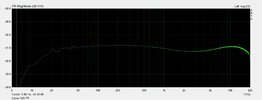
I had the opportunity today to do some bench testing of the Carver 350 amplifiers. To start with, we pulled the cover off the output transformer to take a gander at what's in there:

This is a far larger transformer than I found in the 275. It's the same lamination size as the 280 watt Hammond 1650W, but half the stack height, so Hammond would rate something like this around 150W. There's also a nice ding on this one from being dropped, but the buyer would never have known that since it's covered up.
Here are the specs from the website (as of 7/31/2022):

Let's start with power, and I'll just leave the amp with high feedback on to keep the numbers as nice as they can be. At 1kHz into an 8 ohm load on the 8 ohm taps, the Carver 350 makes 7W at 0.5% THD. At 1% THD I see 11.28 and 24W at 2% THD. Moving up to 5kHz I am only able to get 2W at 0.5% THD. Back to 1kHz, I stopped measuring at 170W where distortion was up around 2.8%, which is where you see similar amps rated. Back at 5kHz and 2.8% THD, power is about 14.5W. The power bandwidth is claimed to go down to 24Hz, but at 0.5% THD and 24Hz I was unable to resolve any power. At 1% THD and 24Hz, 9W is available and at 153W THD is 5% and crossover distortion is very visible in the scope trace.
The specifications continue by claiming that the amp will make more power into 4 ohms, though the binding posts on the back for the 4 ohm connection are connected to the 8 ohm post...
At 1kHz, 4 ohms, and 0.5% THD, the 350 makes 4.5W. At 5kHz and 0.5% THD that drops to 2.25W. The amp hard clips at 6% THD and 272W, and 72W are available at 2.8% THD with 4 ohm loading.

Likewise the frequency response is nice, but not as advertised. To get a better stab at the extremes, I abandoned the FFT and just used an AWG and my scope. At 2.83V/1kHz switching the signal to 85kHz leaves me with 1.6V of signal, so about 5dB down at 85kHz. The actual -3dB point is 61kHz. At the bottom end starting at 100Hz (to give some adjustment for the swoopy overall frequency response), the amp is -3dB at 10Hz.
Oddly enough the source impedance from the 4/8 ohm tap is 1 ohm, so better than specified...
This pair of amps will be in the area for a while if there are other areas of interest.
Last edited:



